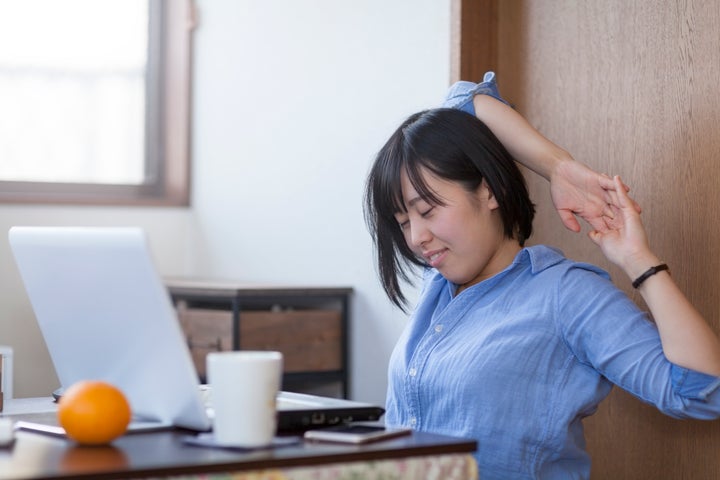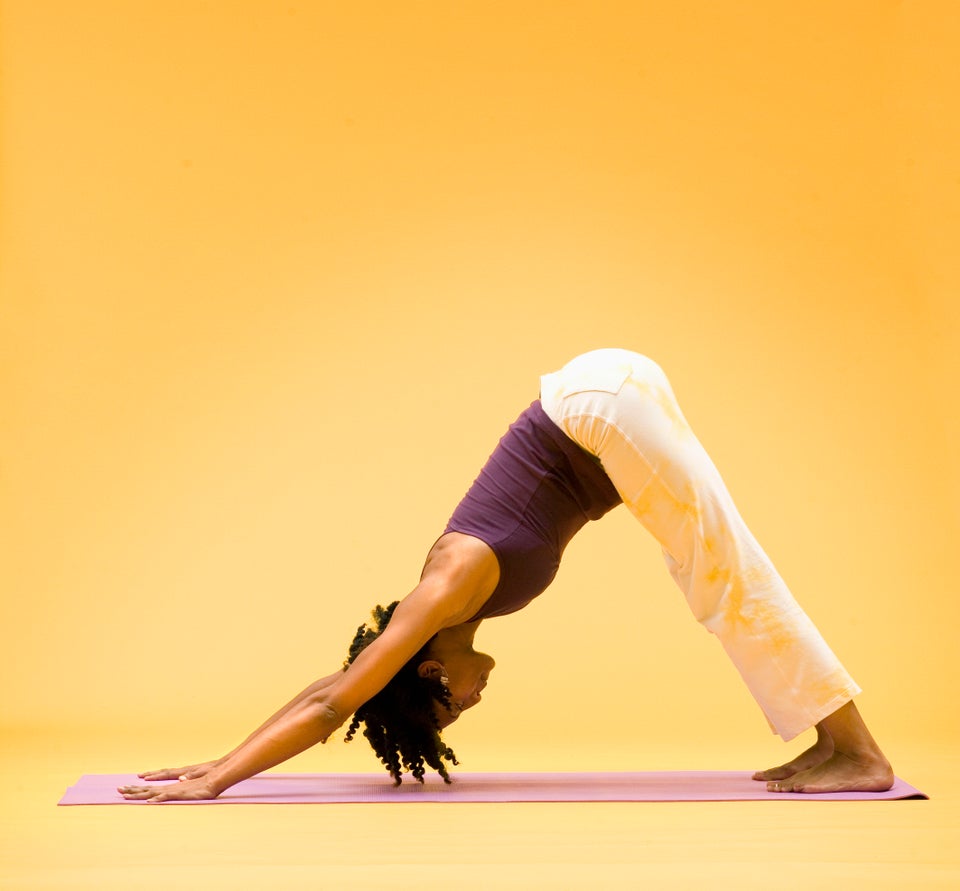Over the past month, many Americans who can do their jobs remotely made the abrupt transition to working from home to prevent the spread of COVID-19, the illness caused by the coronavirus.
If you’re one of them, you may have a less-than-ideal office setup without ergonomic chairs, keyboards or computer monitors, and are experiencing new body aches and pains. Slouching, sitting too long, extending your wrists and relying upon a laptop screen put physical stress on your body that you may not notice but will definitely feel later.
If you are currently holding your neck from the pain of staring down at your laptop, you need to pay attention to what your body is telling you.
“If people wait till things start to hurt, already they’ve waited a little bit too long,” said Alan Hedge, director of the human factors and ergonomics research group at Cornell University.
Keeping your body in a neutral, relaxed position while working is key to avoiding pain, Hedge said. If your work-from-home setup isn’t ergonomic, you will “accelerate the onset of musculoskeletal problems ranging from neck, shoulder, back problems, to hand-wrist problems, to leg problems, all because of working in poor postures,” he said.
Here are some body aches to watch out for and ways to address them:
1. Your neck and shoulders hurt.
If your neck and shoulders are sending you warning pangs, your posture and the way you are looking at your work may be the culprit.
“If you are looking at a low monitor, you are going to be flexing your neck and your head forward and down, which is going to change your posture,” said Karen Loesing, owner of California-based The Ergonomic Expert, which evaluates ergonomics for businesses. “If your monitor is at the correct height, it’s naturally going to pick you up and put you in the back of the chair.”
Solution: Evaluate your work station to isolate what is causing your neck and shoulders to feel off. Cornell University compiled a “Where It Hurts” guide to address questions specific to your work setup.
For shoulder and neck pain, tips from the guide include positioning the monitor at eye level so that your neck and shoulders are in a neutral position and placing frequently-used objects nearby so your body doesn’t have to strain to use them.
If you’re working from home on a laptop and don’t have the money to upgrade right now, there are still ergonomic upgrades you can do that are free. Loesing suggests placing the laptop on a table or desk that is preferably at elbow height. Change locations and positions frequently up to twice an hour to increase your circulation, Loesing recommends.
“The best posture is the next posture,” she said.

2. Your eyes feel fatigued.
When you stare at the glare of a computer screen for too long, you are making your eyes work harder. This habit can lead to digital eye strain that is characterized by headaches, blurred vision, dry eyes, and neck and shoulder pain.
“Eye strain is also common for those who don’t take breaks from the computer screen,” said Loesing.
Solution: Seek natural light and take frequent breaks. To give your eyes a break, follow the 20-20-20 rule endorsed by the American Optometric Association: “Take a 20-second break to view something 20 feet away every 20 minutes.”
If you’re working from a home office, Loesing recommends working near a window with natural light that is preferably at a 90-degree angle to your screen, as opposed to right behind you. “That’s better for your eyes than all this artificial [light],” she said.
“To give your eyes a break, follow the 20-20-20 rule endorsed by the American Optometric Association: 'Take a 20-second break to view something 20 feet away every 20 minutes.'”
3. Your hips are tight.
Your back is actually supposed to recline 15 to 20 degrees to keep your hips open, not be ramrod straight.
“When you’re sitting at 90 degrees, your hip flexors get super tight because they’re kind of squished, so when you go to get up out of your chair, if you haven’t gotten up in a while, it feels like ‘I’m 100 years old,’” Loesing said. “Really tight hip flexors lead to a lot of back pain. It’s a common connection.”
Solution: Recline your seat if your chair is adjustable, and if not, get up frequently. If you are working from a dining chair that has no give and you are hoping that this remote work situation is just temporary, keep your body moving.
“Break at least every 20 minutes and get out of that tight posture,” Loesing said. “The good thing about working at home is that you have that flexibility.”
4. Your legs cramp.
Leg cramps are signs of poor circulation, and the ache is your body telling you that you are not working with good posture. “If you get a cramp in your leg, that’s the muscle saying, ‘Hey, I never had a good blood supply here.’ And if I ask you to sit down kneeling on your leg all day, you’re pretty guaranteed to get a cramp there,” Hedge said.
Solution: Promote good circulation in your legs. One way to do this is to adjust the height of your chair so that your feet are flat on the ground. If that’s not possible, use a footrest. That way there is less pressure on your thighs and the position promotes good circulation, according to Cornell’s “Where It Hurts” guide.
Periodic breaks every 20 minutes to move around are another way to promote good circulation. “When you’re walking around, the muscles of the body are pumping almost as much blood as your heart is pumping,” Hedge said.
5. Your wrists hurt.

If your hands and wrists are straining and aren’t in a neutral position, “That puts more strain on the tendons that go through a structure in your wrist called the carpal tunnel, and [as] those tendons become inflamed, they put pressure on the median nerve, and then you get a problem called carpal tunnel syndrome,” Hedge said.
Carpal tunnel syndrome, which affects 1.9 million Americans, can result in tingling, numbness and muscle weakness in your hands and fingers, according to the Centers for Disease Control And Prevention.
Solution: Keep your wrists flat and straight. You want your wrists to be as flat as possible and straight, so they are not bent left or right.
If it’s possible, look into a keyboard and mouse that will keep your wrists neutral. “If your wrists ache or tire, look into buying an ergonomic keyboard that angles out from the center, making it easier for you to keep your hand and forearm in a straight line,” recommends Princeton University’s health services.
6. Your back aches.
The CDC reports that back pain symptoms are among the top 10 reasons for medical visits in America.
Leaning forward to type, for example, puts strain on your lumbar region, which can lead to back injuries. “If you lean forward, you increase the compression on those vertebrae, you increase it up to 200% compared to if you can sit back in a relaxed position,” Hedge said.
Solution: Make sure your back is supported and not being strained. The goal with ergonomics is to get your body into the best neutral position you can get into, Hedge said.
When your seat is slightly reclined, “the chair starts to work for the body and there are significant decreases in postural muscle activity and in intervertebral disc pressure in the lumbar spine,” Cornell’s guidelines state.
If you are seeking cheap lumbar support, try using a towel. Roll up the towel and put it behind your back so that it preserves the inward bending of the lower back, Hedge said.
- Stay up to date with our live blog as we cover the COVID-19 pandemic
- How long are asymptomatic carriers contagious?
- Heads up: Not all your tax deadlines have been postponed
- I just got out of a COVID-19 ICU. Here’s how I made it through.
- How to make a no-sew coronavirus face mask
- Why some people might have trouble getting their coronavirus rebates payments
- What to do if you live with someone with COVID-19
- There’s a simple game that can stop a tantrum cold
- The HuffPost guide to working from home
- What coronavirus questions are on your mind right now? We want to help you find answers.
- Everyone deserves accurate information about COVID-19. Support journalism – and keep it free for everyone – by becoming a HuffPost member today.
